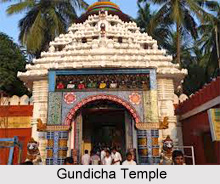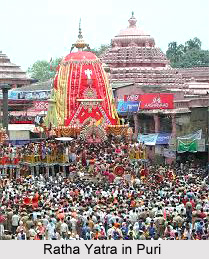 Architecture of Gundicha Temple is influenced from the architecture of Eastern Ganga Dynasty. It is just like the Jagannath Temple of Puri or the Sun Temple of Konark or the Lingaraj Temples of Odisha.
Architecture of Gundicha Temple is influenced from the architecture of Eastern Ganga Dynasty. It is just like the Jagannath Temple of Puri or the Sun Temple of Konark or the Lingaraj Temples of Odisha.
This temple-Gundicha Temple has the mythological and historical significances. The early history of Odisha says that Gundicha was the queen of the King Indradyumna, who was the founder of Lord Jagannath Temple.
It is because of the deep devotion of the queen Gundicha, Lord Jagannath prefers to pay a visit to her house for nine days during the Ratha Yatra. Another history says that Gundicha Ghar is the house of Lord Krishna"s adoring aunt Gundicha.
It is believed that their aunt gives a welcome to the three siblings with a special delicacy made of rice called "padoapitha". This rice cake is also known as "Podapitha" or "Porapitha". Gundicha Temple is regarded as equally holy as Jagannath temple as Lord Jagannth stays here for nine days during Ratha Yatra Festival.
Architectural Style of Gundicha Temple
Gundicha Temple was built in typical Kalingan style, which is predominant in Odisha, Buhar and some parts of the southern part of Bengal. Gundicha Temple is surrounded by a wall and stands in the middle of a garden. The height of the wall of Gundicha Temple is 20 feet and width is 5 feet. The length of Gundicha Temple is 430 feet. The height of Gundicha Temple is about 75 feet.
 Rooms in Gundicha Temple
Rooms in Gundicha Temple
Gundicha Temple consists of four parts connected with kitchen rooms by a narrow passage. The four structures like Vimana, Jagamohana, Natamandapa and Bhogamandapa, bear the traces of several plastering and are carved in places with obscene figures in mortar.
Stones of Gundicha Temple
Gundicha Temple is built of light grey sand stone. There is a plain raised seat, 4 feet high and 19 feet long, made of chlorite and this is called the "Ratnavedi", the throne on which the images are placed when brought to the temple. This temple has two gates. The western gate is the main gate and the eastern side gate. The eastern gate of Gundicha Temple is also known as Nakachana gate. The deities of Gundicha Temple enter to this temple through the west gate and come out by the east gate. The sanctum features a plain raised platform 4 feet high and 19 feet made of chlorite called Ratnavedi, where the deities are placed during the annual festivities. The temple has two gates. The western gate is the main temple gate, through which the deities enter the temple during Ratha Yatra. The eastern gate, known as Nakachana gate, is used for the departure of the deities.
Derivation of Gundicha Temple
Gundicha Temple is known as the Garden House of Jagannath. Gundicha temple stands in the centre of a beautiful garden, surrounded by compound walls on all sides. It lies at a distance of about 3 kilometres from the Shrimandira, the main temple of Jagannath.





















